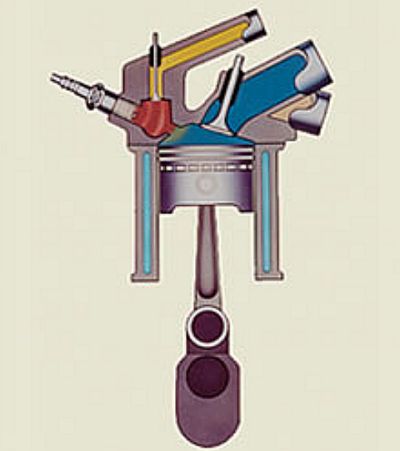I'm not one to use the term 'breakthrough' lightly, but I think it may be applicable to the Merritt Unthrottled Spark Ignition Combustion engine, after studying its theory. Read this link for a first contact.
Let me give a little background. A conventional petrol/gasoline engine, unlike a diesel, uses a ± constant fuel/air ratio at all speeds, to ensure optimal ignition. To achieve this, at low speeds, the air intake is throttled back. Nevertheless, the combustion within the cylinder takes place at a constant temperature. This is why the efficiency is comparatively low, compared with a diesel. The latter has no throttle, so that a full dose of air is taken into the cylinder at each cycle. On the compression stroke, the adiabatic compression of this full dose of air causes its temperature to rise. The fuel is injected in, in the form of a fine liquid spray, and each microdroplet of fuel combusts because the air temperature exceeds the flame point of the fuel. At low engine speeds, little fuel is injected, even though the volume of air is great. This technique cannot normally be applied to a petrol engine with spark ignition, because the petrol:air ratio must be near-stoichiometric for ignition of the fuel.
Prof. Merritt had the idea of stratifying the air in the cylinder, so that the petrol is injected away from the spark plug, and a swirl of the laminar stratified air/fuel mixture, in near-stoichiometric proportions is taken to the plug, where it is ignited. This is with unthrottled air, where a full dose is taken into the cylinder at each cycle. In practice, this is done in a very small combustion chamber, housed in the cylinder head. A second injector injects more fuel, according to power requirements, past the mini-combustion chamber into the main combustion chamber and this burns as soon as soon as it finds enough oxygen, being ignited from the first injection. Obviously, the timing of the two injections and the spark are critical. The fact that the air is not all used at low speeds lowers the temperature of the combustion and increase the efficiency.
This link gives diagrams and a better description while this link shows the practical implementation.
I think this is an exciting development because the extra cost for a 20% efficiency improvement would be very small for mass manufacture. I'd love to see it applied to an Atkinson cycle engine: a good 50% efficiency???
Let me give a little background. A conventional petrol/gasoline engine, unlike a diesel, uses a ± constant fuel/air ratio at all speeds, to ensure optimal ignition. To achieve this, at low speeds, the air intake is throttled back. Nevertheless, the combustion within the cylinder takes place at a constant temperature. This is why the efficiency is comparatively low, compared with a diesel. The latter has no throttle, so that a full dose of air is taken into the cylinder at each cycle. On the compression stroke, the adiabatic compression of this full dose of air causes its temperature to rise. The fuel is injected in, in the form of a fine liquid spray, and each microdroplet of fuel combusts because the air temperature exceeds the flame point of the fuel. At low engine speeds, little fuel is injected, even though the volume of air is great. This technique cannot normally be applied to a petrol engine with spark ignition, because the petrol:air ratio must be near-stoichiometric for ignition of the fuel.
Prof. Merritt had the idea of stratifying the air in the cylinder, so that the petrol is injected away from the spark plug, and a swirl of the laminar stratified air/fuel mixture, in near-stoichiometric proportions is taken to the plug, where it is ignited. This is with unthrottled air, where a full dose is taken into the cylinder at each cycle. In practice, this is done in a very small combustion chamber, housed in the cylinder head. A second injector injects more fuel, according to power requirements, past the mini-combustion chamber into the main combustion chamber and this burns as soon as soon as it finds enough oxygen, being ignited from the first injection. Obviously, the timing of the two injections and the spark are critical. The fact that the air is not all used at low speeds lowers the temperature of the combustion and increase the efficiency.
This link gives diagrams and a better description while this link shows the practical implementation.
I think this is an exciting development because the extra cost for a 20% efficiency improvement would be very small for mass manufacture. I'd love to see it applied to an Atkinson cycle engine: a good 50% efficiency???




 Fractal Design Arc Mini R2, 3800X, Asus B450M-PRO mATX, 2x8GB B-die@3800C16, AMD Vega64, Seasonic 850W Gold, Black Ice Nemesis/Laing DDC/EKWB 240 Loop (VRM>CPU>GPU), Noctua Fans.
Fractal Design Arc Mini R2, 3800X, Asus B450M-PRO mATX, 2x8GB B-die@3800C16, AMD Vega64, Seasonic 850W Gold, Black Ice Nemesis/Laing DDC/EKWB 240 Loop (VRM>CPU>GPU), Noctua Fans.
Comment